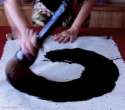Neurotheology research plan (I): motor system
 One high-level hypothesis that should be part of a neurotheology research plan is this: religious practices such as meditation give rise to persistent neurological changes. Although most studies to date have focused on neurological changes during meditation, research such as Lutz et al supports the existence of long-term changes.
One high-level hypothesis that should be part of a neurotheology research plan is this: religious practices such as meditation give rise to persistent neurological changes. Although most studies to date have focused on neurological changes during meditation, research such as Lutz et al supports the existence of long-term changes.
One way to verify such persistent changes is to examine the motor behavior of adherents. For instance, Zen masters demonstrate an intriguing economy of physical movement. In his voluminous treatment of neurological aspects of Zen, Austin spends a mere half-dozen pages discussing this topic, noting that there are three different occasions when forms of what he calls “behavioral enhancement” occur: two after peak and absorption experiences, the other more gradually as training progresses. He infers that the use of the subjects’ frontoparietal, basal ganglia, and cerebellar systems are “integrated, graceful, and efficient.” He goes on to outline a research plan:
The objective studies necessary will have begun long before by careful recordings of the subject’s baseline performance skills. Later, these will be compared with the same person’s skills immediately after major absorptions and kensho, respectively, and then repeated during subsequence years of follow-up studies as the subject moves further along the path.
Such ambitious longitudinal studies would, of course, be a major undertaking.
In my research, I would attempt to define and measure efficiency of motor functioning. I would propose neurological mechanisms (additive or subtractive) through which mental training might affect biokinesiology. I would design imaging experiments to build on these hypotheses. It would be important to understand taxonomies of religion-based meditative practices and map out differences in their neurology. And I would build computer models to validate the plausibility of those mechanisms (this subfield known as “computational neurotheology”).
Our subjects need not be limited to meditators from the Buddhist school. One interesting possibility is to study the effect of meditation on various motor impairments; down the road one might hope for results useful in dealing with Parkinson’s or apraxic disorders. Christianity has a rich tradition of meditation-like mental training and prayer practices, which should also be integrated into this research.
A small amount of research exists on this topic, much of it on Transcendental Meditation (see an excellent searchable bibliography at the “Physical and Psychological Effects of Meditation” site):
- Warshal D., Effects of the Transcendental Meditation Technique on Normal and Jendrassik Reflex Time. Perceptual & Motor Skills 50:1103-6, 1980
- Robertson DW, The Short and Long Range Effects of the Transcendental Meditation technique on Fractionated Reaction Time. J Sports Med Physical Fitness 23(1):113-20, Mar 1983 (link)
- Williams, L.R., and P.G. Herbert, “Transcendental Meditation and Fine Perceptual Motor Skill.”, Perceptual and Motor Skills 43, no. 1 (1976): 303-309.
- Williams, L.R., and B.L. Vickerman, “Effects of Transcendental Meditation on Fine Motor Skill,” Perceptual and Motor Skills 43, no. 2 (1976): 607-613.
- Wood, C.J., “Evaluation of Meditation and Relaxation on Physiological Response during the Performance of Fine Motor and Gross Motor Tasks,” Perceptual and Motor Skills 62, no. 1 (1986): 91-98.
- Wood, C.J., “Meditation and Relaxation and Their Effect upon the Pattern of Physiological Response during Performance of a Fine Motor and Gross Motor Task,” Dissertation Abstracts International 44, no. 5-A (1983): 1378.
- Blasdell, K.A., “The Effects of the Transcendental Meditation Technique upon a Complex Perceptual-motor Task,” in Scientific Research on the Transcendental Meditation Program: Collected Papers, Vol. 1, eds. D.W. Orme-Johnson and J.T. Farrow. New York: M.E.R.U. Press, 1977.
- Jedrczak, A., M. Toomey, and G. Clements, “The TM-Sidhi Program, Age, and Brief Tests of Perceptual-motor Speed and Nonverbal Intelligence,” Journal of Clinical Psychology 42, no. 1 (1986): 161-164.
- Rimol, A.G., “The Transcendental Meditation Technique and Its Effects on Sensory-motor Performance,” in Scientific Research on the Transcendental Meditation Program: Collected Papers, Vol. 1, eds. D.W. Orme-Johnson and J.T. Farrow. New York: M.E.R.U. Press, 1977.
- Telles, S., B.H. Hanumanthaiah, R. Nagarathna, et al., “Plasticity of Motor Control Systems Demonstrated by Yoga Training,” Indian Journal of Physiology & Pharmacology 39, no. 2 (1994b): 143-144.

May 6th, 2005 at 15:43
With all due repsect to Lutz et al…it sounds like a stretch at best. At worst, it calls to mind ‘research’ done in the 1990s on the effectiveness of prayer, the wonderful, documented, physical results of which turned out to be fraudulent.
I mean, no doubt there are truly astounding physical specimens out there whose control over otherwise autonomous human biological systems is attributable to years of daily meditation practice. But the problem I have is with how the meditation process is defined, measured and controlled. I would venture a guess that the pecentage of meditators who succeed in bringing about noticeable physical changes is probably somewhere between 0.05%-0.10% of the total number of meditators. Which is still plenty of people considering the ranks of meditators the world over, only you don’t know which ones are going to succeed at it.
It also seems impossible with today’s medical technology to compare what two different meditators may be doing inside their heads, assuming that they accomplish the same effects.
If Mr. Myers still gets his quarterly rag from RPI, there is a good article in the current one about the directions and goals RPI’s cognitive research program. They’re doing a lot of nuts and bolts type stuff in observing, recording physical activites and correlating them to what’s going on in the study participants’ heads at the same time. Perhaps the RPI folks would be willing to team up with Lutz, or at least share the RPI methodology.
December 4th, 2009 at 04:12
[…] identifiable differences in motor functioning which can be related to brain structure? (Motor systems, Mirror neurons and […]